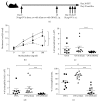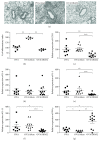OK-432 Acts as Adjuvant to Modulate T Helper 2 Inflammatory Responses in a Murine Model of Asthma
- PMID: 30402504
- PMCID: PMC6196917
- DOI: 10.1155/2018/1697276
OK-432 Acts as Adjuvant to Modulate T Helper 2 Inflammatory Responses in a Murine Model of Asthma
Abstract
Enhanced type 2 helper T (Th2) cell responses to inhaled harmless allergens are strongly associated with the development of allergic diseases. Antigen formulated with an appropriate adjuvant can elicit suitable systemic immunity to protect individuals from disease. Although much has been learned about Th1-favored immunomodulation of OK-432, a streptococcal preparation with antineoplastic activity, little is known about its adjuvant effect for allergic diseases. Herein, we demonstrate that OK-432 acts as an adjuvant to favor a systemic Th1 polarization with an elevation in interferon- (IFN-) γ and ovalbumin- (OVA-) immunoglobulin (Ig) G2a. Prior vaccination with OK-432 formulated against OVA attenuated lung eosinophilic inflammation and Th2 cytokine responses that were caused by challenging with OVA through the airway. This vaccination with OK-432 augmented the ratios of IFN-γ/interleukin- (IL-) 4 cytokine and IgG2a/IgG1 antibody compared to the formulation with Th2 adjuvant aluminum hydroxide (Alum) or antigen only. The results obtained in this study lead us to propose a potential novel adjuvant for clinical use such as prophylactic vaccination for pathogens and immunotherapy in atopic diseases.
Figures




Similar articles
-
In interleukin-4-deficient mice, alum not only generates T helper 1 responses equivalent to freund's complete adjuvant, but continues to induce T helper 2 cytokine production.Eur J Immunol. 1996 Sep;26(9):2062-6. doi: 10.1002/eji.1830260915. Eur J Immunol. 1996. PMID: 8814247
-
Prophylactic vaccination with adjuvant monophosphoryl lipid a prevents Th2-mediated murine asthmatic responses.J Asthma. 2013 May;50(4):327-33. doi: 10.3109/02770903.2013.769268. Epub 2013 Feb 20. J Asthma. 2013. PMID: 23343407
-
Intranasal IL-12 produces discreet pulmonary and systemic effects on allergic inflammation and airway reactivity.Int Immunopharmacol. 2003 Apr;3(4):457-68. doi: 10.1016/S1567-5769(02)00250-3. Int Immunopharmacol. 2003. PMID: 12689651
-
Immunomodulation in asthma: mechanisms and possible pitfalls.Curr Opin Pharmacol. 2003 Jun;3(3):220-6. doi: 10.1016/s1471-4892(03)00038-9. Curr Opin Pharmacol. 2003. PMID: 12810183 Review.
-
Particulate adjuvant and innate immunity: past achievements, present findings, and future prospects.Int Rev Immunol. 2013 Apr;32(2):209-20. doi: 10.3109/08830185.2013.773326. Int Rev Immunol. 2013. PMID: 23570316 Free PMC article. Review.
References
MeSH terms
Substances
LinkOut - more resources
Full Text Sources
Medical

